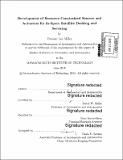| dc.contributor.advisor | David W. Miller and Alvar Saenz-Otero. | en_US |
| dc.contributor.author | Miller, Duncan Lee | en_US |
| dc.contributor.other | Massachusetts Institute of Technology. Department of Aeronautics and Astronautics. | en_US |
| dc.date.accessioned | 2015-09-17T19:05:36Z | |
| dc.date.available | 2015-09-17T19:05:36Z | |
| dc.date.copyright | 2015 | en_US |
| dc.date.issued | 2015 | en_US |
| dc.identifier.uri | http://hdl.handle.net/1721.1/98697 | |
| dc.description | Thesis: S.M., Massachusetts Institute of Technology, Department of Aeronautics and Astronautics, 2015. | en_US |
| dc.description | Cataloged from PDF version of thesis. | en_US |
| dc.description | Includes bibliographical references (pages 171-177). | en_US |
| dc.description.abstract | Most satellites on-orbit today are not intended to physically approach or interact with other spacecraft. However, the robotic servicing of orbiting assets will be an economically desirable (and often scientifically necessary) capability in future space enterprises. With the right set of tools and technologies, satellites will be able to autonomously refuel, repair, or replace each other. This has the potential to extend mission lifetimes, reduce orbital debris and make space more sustainable. Spacecraft may also assemble on-orbit into larger aggregate spaceflight systems, with applications to sparse aperture telescopes, solar power stations, fuel depots and space habitats. The purpose of this thesis is to address the highest risk elements associated with the docking and servicing of satellites: the sensors, actuators, and associated algorithms. First, a peripheral agnostic robotics platform is introduced, upon which a suite of technology payloads may be developed. Next, a flight qualified docking port for small satellites is presented, and the results detailing its operation in a relevant environment are discussed. In addition, we review a high precision relative sensor designed to enable boresight visual docking. The measurements from this optical camera are applied to a nonlinear estimator to provide the highly accurate sensing necessary for docking. Finally, a free-flying robotic arm is examined and modeled as an experimental payload for the SPHERES Facility on the International Space Station. | en_US |
| dc.description.statementofresponsibility | by Duncan Lee Miller. | en_US |
| dc.format.extent | 197 pages | en_US |
| dc.language.iso | eng | en_US |
| dc.publisher | Massachusetts Institute of Technology | en_US |
| dc.rights | M.I.T. theses are protected by copyright. They may be viewed from this source for any purpose, but reproduction or distribution in any format is prohibited without written permission. See provided URL for inquiries about permission. | en_US |
| dc.rights.uri | http://dspace.mit.edu/handle/1721.1/7582 | en_US |
| dc.subject | Aeronautics and Astronautics. | en_US |
| dc.title | Development of resource-constrained sensors and actuators for in-space satellite docking and servicing | en_US |
| dc.title.alternative | Development of resource-constrained sensors and actuators to achieve in-space satellite docking and servicing | en_US |
| dc.type | Thesis | en_US |
| dc.description.degree | S.M. | en_US |
| dc.contributor.department | Massachusetts Institute of Technology. Department of Aeronautics and Astronautics | |
| dc.identifier.oclc | 920688474 | en_US |
